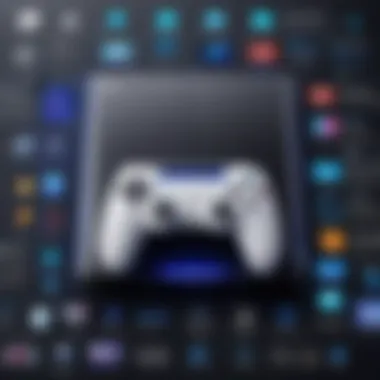In-Depth Overview of Sony's PlayStation 5 and Its Impact


Intro
The gaming landscape has evolved significantly in recent years. One of the most notable advancements is Sony’s PlayStation 5, which has generated a remarkable response since its launch. This article provides an analysis of the PS5, focusing on its technical specifications and unique features. It examines factors such as performance metrics, usability, and the broader implications for the gaming industry and technology. Understanding these components is essential for IT professionals and tech enthusiasts interested in gaming and its future directions.
Performance Metrics
Performance metrics are a critical area to explore when analyzing the PlayStation 5. The console's capabilities in benchmarking highlight its advanced architecture and design. Below are some key aspects of its performance:
- Benchmarking results: The PS5 showcases impressive performance benchmarks compared to its predecessor and competing systems. Games run smoothly at high resolutions, maintaining frame rates that enhance user enjoyment. The custom SSD allows for rapid game loading times, which drastically reduces waiting periods.
- Speed and responsiveness: Speed is enhanced by the PS5's architecture. The console integrates a custom-designed AMD processor capable of delivering remarkable speeds. Gamers appreciate the responsiveness, which contributes to a more immersive experience. Moreover, this speed translates into seamless transitions among applications, whether in gaming or streaming services.
Usability and User Experience
For a gaming console, usability and user experience are paramount. Sony has designed the PS5 with both new and experienced users in mind. Important components include:
- Ease of installation and setup: Setting up the PS5 involves straightforward steps. Users can connect the console to their display and power source, and the initial setup is intuitive. The user-friendly interface guides players through configuration, making it accessible for all.
- Interface design and navigation: The PS5 interface is sleek and organized, which simplifies navigation. Features are easy to locate, and the layout supports quick access to games and settings. Updates and game installations can occur in the background, allowing users to enjoy their gaming experience uninterrupted.
"The PS5’s user interface is designed to be both efficient and aesthetic. Its focus on user experience sets a new standard in gaming."
- Gaming Analyst
The PlayStation 5 plays a pivotal role in shaping the current and future landscapes of gaming and technology. Its performance metrics highlight its capabilities, while usability features ensure that players can navigate the console easily. As we explore more sections of this article, we will examine how the PS5 influences market trends and technology advancements.
Prologue to PlayStation
The PlayStation 5 (PS5) represents not only a significant advancement in gaming hardware but also a cultural phenomenon that shapes the gaming landscape. This section serves as an essential touchpoint for understanding the role of the PS5 in the current market and within the broader technological framework. With its powerful specifications, innovative features, and user-focused design, the PS5 has established a new standard for what gamers can expect from their consoles.
Historical Context
The history of the PlayStation brand is rich and complex, marked by several significant milestones. The original PlayStation was released in 1994 by Sony Computer Entertainment, marking the company's entry into the gaming console market. Over the years, each iteration has built off the last, responding to technological advancements and shifting consumer expectations. The PlayStation 2, released in 2000, solidified the brand’s dominance. Later, the PlayStation 3 introduced online gaming capabilities and high-definition graphics. However, it was the PlayStation 4, launched in 2013, that refined the user experience, emphasizing both hardware power and social interaction.
The PS5 continues this trend by leveraging advancements in graphics and processing technology, setting itself apart from previous generations. With features like ultra-fast SSD storage and immersive gameplay through advanced graphics capabilities, the PS5 addresses both gamer demands and industry trends. Understanding this history is crucial for assessing the PS5's impact on contemporary gaming.
Release Timeline
The PS5 was officially announced in June 2020, generating substantial anticipation in the gaming community. Its launch on November 12, 2020, marked a new chapter for Sony amidst a competitive landscape. Following its release, the PS5 saw immediate demand, characterized by supply issues that resulted from overwhelming interest. As a result, it became one of the fastest-selling consoles in history.
Post-launch, Sony continued to support the PS5 with firmware updates and new game releases, ensuring that the console remains relevant in an evolving market. The ongoing updates also reflect Sony's commitment to improving user experience and addressing community feedback.
In summary, the introduction of the PlayStation 5 is a pivotal moment in gaming history. It stands at the intersection of technological achievement and cultural significance, laying the groundwork for future developments in the industry. Understanding the historical context and the timeline of its launch allows for deeper appreciation of the innovations that the PS5 brings to both gaming and technology.
Technical Specifications
Understanding the technical specifications of the PlayStation 5 is essential for grasping its power and capabilities in the gaming industry. This section delineates the advanced components that contribute to the console's performance. With high-end specifications, the PS5 stands as a benchmark for gaming hardware, influencing both game developers and consumers alike.
Processor Architecture
The PlayStation 5 utilizes a custom AMD Zen 2 processor, which is pivotal for delivering extraordinary performance. This processor architecture is built on 7nm technology, a key factor in its energy efficiency and processing power. With 8 cores and 16 threads, the CPU can handle multitasking effectively, allowing for complex in-game mechanics and extensive AI calculations without lag.
One significant aspect of this architecture is its ability to optimize game load times. The custom SSD paired with the CPU reduces bottlenecks that were common in previous generations. The versatility of the Zen 2 architecture ensures that game developers can fully utilize its power, creating rich and immersive experiences.


Graphics Capabilities
The PS5 features a custom RDNA 2 GPU from AMD, making it capable of exceptional graphics rendering. With a performance of 10.28 teraflops, it supports ray tracing technology, significantly improving visual fidelity. This creates realistic lighting, shadows, and reflections, enhancing overall immersion.
Moreover, the GPU supports 4K gaming at up to 120 frames per second, a crucial advancement for competitive gaming and high-fidelity visuals. Developers benefit from this capability to design games that are not only visually stunning but also technically sophisticated. The hardware's ability to handle high frame rates and resolutions positions the PS5 as a leader in the current gaming landscape.
Storage Solutions
In terms of storage, the PlayStation 5 incorporates an 825 GB custom SSD. This is a radical departure from traditional hard drives, contributing immensely to its speed and performance. The SSD enables zero-load times, which enhances player experience by allowing seamless transitions between levels and environments.
Additionally, the PS5 supports expandable storage via NVMe SSDs. Users can add storage to accommodate larger game libraries without sacrificing performance. This flexibility is an important consideration for gamers today, who prefer convenience alongside technology.
Key Features of PS5
The PlayStation 5 introduces several key features that substantially enhance the gaming experience. These features stem from a thoughtful consideration of user needs, technological advancements, and market demands. This section focuses on the pivotal aspects that define the PS5, emphasizing the DualSense controller innovations, user interface experience, and backward compatibility options. By examining these elements, readers can grasp how the PS5 positions itself as a leader in the evolving gaming landscape.
DualSense Controller Innovations
The DualSense controller is a significant leap forward from its predecessor, the DualShock 4. Its haptic feedback technology provides users with tactile sensations that mimic real-world interactions. This feature allows for a more immersive gaming experience, as players can feel differing textures and actions in various game environments. The adaptive triggers also add a new layer of gameplay; they can alter resistance based on in-game actions. For example, drawing a bow will feel different compared to pressing a pedal in a racing game. Such responsiveness enhances realism and player engagement but also reflects a growing trend in gaming towards sensory immersion.
User Interface and Experience
The PS5 user interface is designed to be intuitive and player-focused. Upon booting up the console, players are greeted with a sleek design that prioritizes accessibility and information. The Control Center, for example, serves as a shortcut menu to various activities, allowing quick access to games and settings without interrupting gameplay. This approach streamlines the user experience, ensuring that players can find what they need with minimal disruption. Overall, the UI reflects a modern aesthetic while catering to the functionality that current gamers expect.
Backward Compatibility Options
Backward compatibility is a crucial aspect for many consumers, and the PS5 supports a broad range of PS4 titles. This allows players to access their existing library without the need for re-purchasing games. Not all titles are guaranteed to be compatible, but Sony has made efforts to ensure a large selection is available. This feature not only appeals to long-time players but also aids in transitioning to the new console. It effectively reduces the friction often associated with upgrading systems, providing a seamless experience for gamers wanting to explore new titles on the PS5 while still enjoying their favorites from the past.
In summary, the PS5's key features such as the DualSense innovations, thoughtful user interface, and robust backward compatibility reflect Sony’s commitment to advancing gaming technology while addressing the evolving needs of its user base.
Market Reception and Sales Performance
Analyzing the market reception and sales performance of the PlayStation 5 (PS5) is essential for understanding its impact on the gaming industry. This section will explore critical sales metrics, consumer feedback, and overall market trends that influenced the PS5’s positioning among competitors. Through examining these facets, we can garner insights into the console's acceptance in an ever-evolving market.
Sales Metrics
The sales metrics for the PS5 reflect not only its popularity but also its ability to resonate with gamers and non-gamers alike. Since its release, the PS5 has consistently broken records, becoming one of the fastest-selling consoles in history. According to recent estimates, Sony has sold over 30 million units as of early 2023, which is a significant benchmark compared to previous console launches.
Factors contributing to robust sales performance include:
- Initial Demand: The pent-up demand from the global pandemic saw an increased interest in gaming, propelling sales even further during the holiday seasons.
- Limited Availability: Shortages at launch period created a sense of urgency among potential buyers. Scarcity boosted desirability, impacting the secondary market as well.
- Marketing Strategy: Targeted campaigns effectively highlighted unique features, such as the DualSense controller and its exclusives, capturing consumer attention.
These sales metrics provide a foundational overview of the PS5’s impact on the market, illustrating its immediate acceptance and enduring relevance to consumers.
Consumer Feedback and Critique
Consumer feedback is critical in gauging user satisfaction and understanding potential shortcomings. The PS5 has received a mixed yet largely favorable reception. Users praised its speed and interface innovations but voiced concerns about availability and backward compatibility.
Noteworthy points from consumer feedback include:
- Performance Praise: Users frequently commend the fast load times offered by the SSD, enhancing the overall gaming experience. Many express enthusiasm for the gameplay fluidity.
- Controller Features: The DualSense controller has garnered significant acclaim, especially regarding its haptic feedback, which sets a new standard for immersion.
- Critiques on Stock: A recurring theme in reviews and discussion forums is the frustration regarding stock availability. Many potential customers experienced challenges in securing a console.


As a summary, consumer feedback on the PS5 highlights both its strengths and weaknesses, offering valuable insights for ongoing development and marketing strategies.
While the PS5 excels in performance and features, ongoing issues like stock problems highlight the need for better supply chain management going forward.
Competitive Landscape
The importance of the competitive landscape in the context of Sony's PlayStation 5 (PS5) cannot be overstated. This section analyzes how the PS5 positions itself against other gaming consoles, predominantly Microsoft’s Xbox Series X. Understanding this competition is crucial for gaining insights into market dynamics, consumer preferences, and technological advancements.
Examining competitive dynamics sheds light on how companies innovate and adapt. It highlights the need for ongoing enhancements in gaming experience, UI, and exclusive offerings. This competition pushes companies to refine their products, which ultimately benefits consumers and leads to a vibrant gaming ecosystem.
Comparative Analysis with Xbox Series
When comparing the PS5 with Xbox Series X, several fundamental differences emerge. Both consoles aim to deliver exceptional gaming experiences, yet their approaches differ significantly in key areas.
- Performance Metrics: The PS5 boasts a custom SSD with ultra-fast loading speeds while Xbox Series X leverages a similar SSD but emphasizes storage capacity. Thus, PS5's game load times are shorter, enhancing user experience significantly.
- Controller Experience: The PS5's DualSense controller introduces adaptive triggers and haptic feedback, making gameplay more immersive. On the other hand, Xbox Series X focuses on comfortable ergonomics and durability. Both approaches cater to varied player preferences.
- Exclusive Titles: Sony has a strong portfolio of exclusive games like "Demon's Souls" and "Ratchet & Clank: Rift Apart," positioning PS5 as a destination for gamers seeking unique experiences. Conversely, Xbox Series X offers titles through Game Pass, increasing accessibility rather than exclusivity.
- User Interface: The PS5's interface is designed with simplicity and ease of access in mind, whereas Xbox’s interface offers deeper customization options.
Impact on Gaming Franchises
The PS5 has had significant impact on various gaming franchises, including pivotal shifts in game design and distribution. As developers grow familiar with the hardware, they leverage the PS5's capabilities to enhance gameplay.
- Game Development: Higher processing power allows for more complex models and richer worlds. Games like "Final Fantasy XVI" demonstrate the ability of next-gen consoles to handle intricate graphics and expansive narratives.
- Multiplayer Experience: Online games have evolved, shifting towards seamless cross-platform play and enhanced connectivity. Titles like "Call of Duty: Warzone" exploit the PS5's capabilities for smoother play and better graphics.
- Indie Game Growth: The PS5 provides indie developers tools and support. This results in a surge of innovative titles that push boundaries, creating a diverse gaming library.
"The PS5's architecture marks a turning point for game development, providing new opportunities for storytelling and gameplay mechanics."
In summary, the PS5 significantly shapes how games are crafted and experienced. Its influence extends beyond its library, affecting development practices across the gaming industry. Companies seeking to thrive must adapt to these advancements fueled by competition and innovation.
Software Ecosystem
The software ecosystem of the PlayStation 5 (PS5) is critical for understanding its broad influence on gaming and technology. It encompasses the range of games available, the platforms through which these games are accessed, and how these elements interrelate to shape the overall user experience. This ecosystem is not just about the games themselves but also about how they interact with the hardware, services, and community surrounding the PS5.
Exclusive Titles
Exclusive titles play a pivotal role in the PS5's software ecosystem. These games are only available on the PS5, creating a unique selling point that draws players toward the console. Notable examples include Demon's Souls, Ratchet & Clank: Rift Apart, and Returnal. These titles are optimized to take full advantage of the PS5’s hardware capabilities, including its advanced graphics and fast load times due to SSD storage.
The impact of exclusive titles is twofold. First, they enhance the value of the PS5 by providing experiences that players cannot obtain elsewhere. Second, they often set trends in game design, pushing the industry toward innovation and new gameplay mechanics. Game developers often leverage the PS5’s unique features, like the DualSense controller's haptic feedback, to create more immersive worlds and dynamic gameplay experiences. This leads to higher engagement levels and helps to establish a loyal user base.
Subscription Services and Game Access
Subscription services have become a significant component of the PS5's software ecosystem. Sony’s PlayStation Plus offers gamers access to a library of games for a monthly fee. The recent introduction of PlayStation Now, which allows players to stream and download games, further expands this service's appeal.
These services present several benefits:
- Cost-effective access: Users can enjoy a curated selection of titles without needing to purchase each game outright.
- Regular updates and new content: Subscribers benefit from an evolving library that keeps the gaming experience fresh and engaging.
- Community and multiplayer features: Subscription services often include online multiplayer access, allowing players to connect easily with friends and communities.
The availability of games through subscription models influences player behavior. Gamers can experiment with titles they might not buy, leading to broader exposure and potentially rising sales for games outside the subscription. This shift towards subscriptions also prompts developers to consider models beyond traditional storytelling - encouraging more innovative gameplay structures and social interactions.
"The PS5’s software ecosystem is a living entity, constantly evolving and adapting to the needs of its user base."
Technological Innovations Stemming from PS5
The PlayStation 5 has fundamentally altered the landscape of gaming technology. Its innovations transcend mere hardware upgrades; they set a framework for future developments in the gaming industry. The PS5 not only enhances user experience through improved performance but also influences how games are developed and played. This section will detail the key technological advancements associated with the console, particularly focusing on cloud gaming and virtual reality capabilities.


Cloud Gaming Integration
Cloud gaming has emerged as a significant trend in the gaming world, and the PlayStation 5 incorporates this movement effectively. Through services like PlayStation Now, users can stream games directly to their consoles or compatible devices. This approach eliminates the need for large downloads and extensive storage requirements, thereby making gaming more accessible to a broader audience.
The PS5’s integration of cloud gaming is pivotal for several reasons:
- Accessibility: More players can join the gaming ecosystem without investing in high-end hardware.
- Diverse Game Library: By offering access to a plethora of titles, Sony encourages exploration of various genres and styles.
- Seamless Experience: Users can switch between different devices while enjoying their favorite games, enhancing convenience.
However, this advancement comes with challenges. Reliance on internet connectivity and the potential for latency issues might hinder gameplay quality for some users. Additionally, the question of ownership arises; players may not own the games they access through streaming, relying instead on subscription models.
Cloud gaming is reshaping how players interact with video games, creating opportunities and raising new concerns about the future of gaming ownership.
Virtual Reality Compatibility
The PS5 is designed to support virtual reality, aligning with Sony’s aims to enhance immersive experiences. The introduction of the PlayStation VR headset, coupled with the performance capabilities of the PS5, allows developers to create more complex and engaging virtual environments. This compatibility exemplifies a significant leap in gaming technology.
Key points regarding virtual reality on the PS5 include:
- Enhanced Graphics Capabilities: The powerful GPU of the PS5 enables detailed and realistic VR environments, leading to richer experiences for players.
- Increased Interaction: The DualSense controller’s haptic feedback and adaptive triggers offer players deeper immersion through realistic interactions in virtual settings.
- Future Potential: As VR technology evolves, the PS5 sets a strong foundation for future developments in immersive gaming.
The combination of these factors positions the PS5 as a leader in the push for VR adoption, potentially attracting more developers to create VR content. However, the accessibility of high-quality VR experiences remains a consideration. Development costs and the need for specialized hardware may limit widespread adoption.
In summary, the technological innovations stemming from the PlayStation 5 have considerably influenced gaming and technology. Its cloud gaming and virtual reality features not only enhance user engagement but also set a tone for future advancements within the gaming ecosystem.
Future Prospects
The examination of future prospects for Sony's PlayStation 5 holds significance as it highlights possible trajectories for both the console and the gaming landscape. As technology rapidly advances, understanding what lies ahead can help inform consumers, developers, and industry stakeholders. This section will delve into two key areas: potential hardware updates and evolving game development trends. Both elements are crucial for anticipating the consoles ongoing impact on the gaming world.
Potential Hardware Updates
Future hardware updates for the PlayStation 5 may reshape the gaming experience significantly. One major consideration is the potential for enhanced processing power. As games become more complex and demanding, Sony might opt to introduce upgraded versions of the PS5, similar to the PlayStation 4 Pro. Such an update could include a more powerful GPU, resulting in improved graphics and frame rates, enhancing the overall gameplay experience.
Additionally, the storage solutions may also see improvements. The PS5 currently utilizes a fast SSD allowing for quick load times. However, newer technologies like PCIe 5.0 are emerging. Integrating these advancements could provide even faster read and write speeds, benefiting a range of game genres from open-world to action-adventure.
"Technological enhancements can elevate the gaming experience, making previous hardware limitations a relic of the past."
Furthermore, support for emerging gaming trends like 8K graphics could come into play as displays evolve. This may mean upgraded HDMI ports or other connectivity options that cater to higher resolutions.
Evolving Game Development Trends
As the PlayStation 5 evolves, so too does the landscape of game development. The integration of artificial intelligence is becoming increasingly important in the industry. Developers are beginning to apply AI-driven algorithms to enhance NPC behaviors or create more dynamic storylines based on player choices. This trend could lead to more immersive experiences on PS5.
Additionally, the rise of cloud gaming is notable. Already seen in services such as PlayStation Now, it allows for games to be streamed rather than downloaded. As internet infrastructure improves worldwide, the PS5 might see greater reliance on cloud capabilities, thus changing the way games are developed and accessed.
Moreover, cross-platform gaming is gaining traction. It allows players to interact with friends regardless of the console they own. This shift could change how titles are designed, as developers would need to consider compatibility factors among multiple systems, including the PS5.
In summary, the future prospects for the PS5 involve significant potential in hardware upgrades and adaptation to new game development trends. These changes will likely influence not just Sony's console but also the entire gaming ecosystem.
The End
In this article, we have examined the PlayStation 5 and its substantial impact on both gaming and technology. The PS5 represents a leap forward in console design, performance, and user experience. Its technological advancements have reshaped expectations, not only for Sony's offerings but for the broader gaming landscape.
Recap of Key Insights
Here are some critical insights that we explored throughout this comprehensive overview:
- Technical Innovations: The PS5's custom AMD processor and SSD storage allow for significantly faster load times and stunning graphics.
- Unique Features: The DualSense controller introduces haptic feedback and adaptive triggers that revolutionize how gamers interact with titles.
- Market Dynamics: The launch of the PS5 has changed competition dynamics, particularly against Microsoft’s Xbox Series X.
- Future Trajectories: As the gaming industry continues adapting to technological trends, the PS5's ecosystem positions it at the forefront of cloud gaming and virtual reality compatibility.



